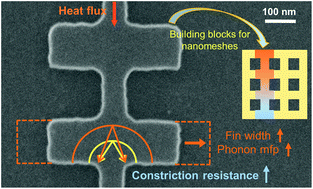Thermal transport through fishbone silicon nanoribbons: unraveling the role of Sharvin resistance†
Abstract
Heat conduction has been shown to be greatly suppressed in Si nanomeshes, which has attracted extensive attention for potential thermoelectric applications, yet the precise suppression mechanism remains to be fully understood. Attempting to further disclose the underlying mechanisms, we report on the thermal conductivity of the building block for nanomeshes, i.e., Si nanoribbons with fins attached to the two opposite sides. By expanding only the fin width while keeping both the period length and the backbone size constant, we observed an unexpected non-monotonic trend of the effective thermal conductivity normalized with the backbone cross-section. Further analysis showed that the corrected thermal conductivity extracted with appropriate consideration of the geometrical effect on diffusion followed a monotonically decreasing trend, reaching a maximum thermal conductivity reduction of 18% at 300 K for a ribbon with the maximum explored fin width of 430 nm, as compared to that of the straight ribbon of 66 nm backbone width. We attribute the thermal conductivity reduction to the thermal constriction resistance induced by the cross-section reduction between the fin and backbone sections. For ribbons with a larger fin width, the effective phonon mean free path is longer for phonons arriving at the constriction, which boosts the ballistic constriction resistance, i.e., Sharvin resistance, and leads to a lower thermal conductivity.

- This article is part of the themed collection: 2019 Nanoscale HOT Article Collection


 Please wait while we load your content...
Please wait while we load your content...